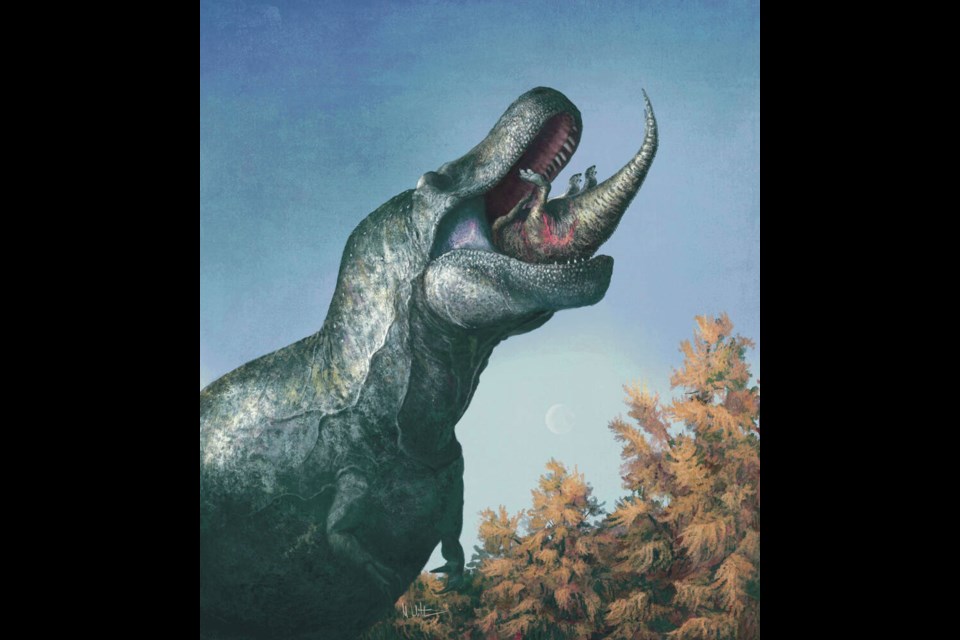The Tyrannosaurus rex, considered the most ferocious dinosaur to ever roam Earth, wasn’t always flashing those giant, bone-crunching teeth.
Turns out, the T. rex had lips — or at least something similar, according to new research.
“Not Angelina Jolie lips … they were more akin to what we see now on a Komodo dragon, more like loose skin that would cover the teeth when the mouth was closed,” said Royal B.C. Museum paleontologist Derek Larson, part of an international team that released the research on what they say is a more accurate portrayal of the prehistoric creatures.
Larson said unlike the images long held by toy makers and Hollywood movies, where the T. rex is shown as always having its fearsome teeth exposed, it’s more likely they were covered with a fleshy skin to protect teeth enamel — similar to modern-day lizards.
The research found other similar dinosaurs such as the Velociraptor, also featured in the Jurassic Park movie franchise, had skin coverings over their teeth.
The study, published this week in Science, comes at an opportune time for British Columbians. One of the T. rex specimens examined for the study is going on display at the Royal B.C. Museum starting June 16.
The Field Museum of Natural History’s T. rex, nicknamed Sue, is the most complete skeleton of a T. rex ever found. It was discovered in 1990 near Faith, North Dakota, and named after fossil hunter Sue Hendrickson, who discovered the bones protruding from an eroded bank. Sue is about 40 feet long and scientists figure it was 26 years old when it died 67 million years ago during the Cretaceous period.
Dinosaur bones have growth rings like trees, according the Chicago-based Field Museum, which paid $84 million US — the highest ever paid for a fossil at auction.
The largest T. rex on fossil record is Scotty, discovered in 1991 near Eastend, Sask., and on display in Regina. Its bones were larger in length, width and circumference — and about 42 feet long, though Sue had larger lower legs.
Larson said researchers have previously suggested that theropod dinosaurs like the T. rex and raptors had exposed teeth, similar to crocodiles, leading to the toothy depiction of predatory dinosaurs in films.
“Our study overturns that idea and seriously brings into question how we reconstruct what certain dinosaurs look like,” said Larson.
With his co-authors, Larson looked to modern lizard examples of lip and tooth structure. From looking at the composition of animal teeth like the Komodo dragon, the researchers determined that the exposed teeth of crocodiles are unique to that group. They found covered teeth are more typical and more probable in extinct animals.
“The crocodile is aquatic, eats fish and evolved specifically,” said Larson. Dinosaurs like the T. rex lived on land and would have developed skin over their teeth to protect them, similar to lizards of today.
The research showed the teeth of lipless animals such as crocodiles have high amounts of wear and abrasions on exposed surfaces. Carnivorous dinosaurs didn’t show a high level of damage on the outer edges, implying that their teeth were not exposed. Perforations around the jaws supplying sensory pathways and blood vessels to the gums are also more lizard-like in dinosaurs than in crocodiles, the research said.
Larson said T. rex’s serrated, conical teeth were about the size of bananas, with about five inches protruding from the gums and an equal amount embedded in the jaw bone. Each of the beasts had between 50 and 60 teeth.
Thomas Cullen of Auburn University in Alabama, the study’s lead author, said predatory dinosaur teeth were not atypically large.
“Even the giant teeth of tyrannosaurs are proportionately similar in size to those of living predatory lizards, [which rejects] the idea that their teeth were too big to cover with lips.”
Larson said the fleshy tooth coverings would be nothing like the lips that belong to humans, which are muscular and mobile, and other mammals. Their research acknowledges that some extinct animals, such as woolly mammoths and the sabre-tooth tiger, and flying or marine reptiles almost certainly had exposed teeth or tusks.
But they say the T. rex and other predatory dinosaurs did not.
Larson hopes the findings will change the way paleontologists reconstruct the soft tissue and appearance of dinosaurs. “I hope it will catch on,” he said. “I think there is already an effort by paleo-artists to do this.
“Accurately reconstructing an extinct animal has huge implications for inferring the behaviour, diet, and evolution of these organisms.”
>>> To comment on this article, write a letter to the editor: [email protected]




